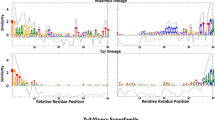Abstract
Previously, we discovered multiple direct repeats of geminivirus-related DNA (GRD) sequences clustered at a single chromosomal position in Nicotiana tabacum (tobacco). Here we show that, in addition to tobacco, multiple copies of these elements occur in the genomes of three related Nicotiana species, all in the section Tomentosae: N. tomentosiformis, N. tomentosa and N. kawakamii, but not in 9 other more distantly related Nicotiana species, nor in various other solanaceous and non-solanaecous plants. DNA sequence analysis of 18 GRD copies reveal 4 distinct, but highly related, sub-families: GRD5, GRD3 and GRD53 in tobacco; GRD5 in N. tomentosiformis and N. kawakamii; and GRD2 in N. tomentosa. In addition to novel sequences, all elements share significant but varying lengths of DNA sequence similarity with the geminiviral replication origin plus the adjacent rep gene. There is extended sequence similarity to REP protein at the deduced amino acid sequence level, including motifs associated with other rolling circle replication proteins. Our data suggest that all GRD elements descend from a unique geminiviral integration event, most likely in a common ancestor of these Tomentosae species.
Similar content being viewed by others
References
Bejarano ER, Khashoggi A, Witty M, Lichtenstein C: Integration of multiple repeats of geminiviral DNA into the nuclear genome of tobacco during evolution. Proc Natl Acad Sci USA 93: 759-764 (1996).
Day AG, Bejarano ER, Buck KW, Burrell M, Lichtenstein CP: Expression of an antisense viral gene in transgenic tobacco confers resistance to the DNA virus tomato golden mosaic virus. Proc Natl Acad Sci USA 88: 6721-6725 (1991).
Devereux J, Haeberli P, Smithies O: A comprehensive set of sequence-analysis programs for the VAX. Nucl. Acids Res 12: 387-395 (1984).
Feinberg AP, Vogelstein B: A technique for radiolabelling DNArestriction endonuclease fragments to high specific activity. Anal Biochem 132: 6-13 (1983).
Gorbalenya AE, Koonin EV, Wolf YI: A new superfamily of putative NTP-binding domains encoded by genomes of small DNA and RNA viruses. FEBS Lett 262: 145-148 (1990).
Greene AE, Allison RF: Recombination between viral-RNA and transgenic plant transcripts. Science 263: 1423-1425 (1994).
Hanahan D: Techniques for transformation of E. coli.In Glover DM (ed) DNA Cloning: A Practical Approach, vol. 1 pp. 109- 135. IRL Press (1985).
Higgins DG, Fuchs R, Bleasby A: CLUSTAL V: a new multiple sequence alignment program. Comput Appl Biosci 8: 189-191 (1992).
Ilyina TV, Koonin EV: Conserved sequence motifs in the initiator proteins for rolling circle DNA-replication encoded by diverse replicons from eubacteria, eukaryotes and archaebacteria. Nucl Acids Res 20: 3279-3285 (1992).
Kenton A, Khashoggi A, Parokonny A, Bennett MD, Lichtenstein C: Chromosomal location of endogenous geminivirusrelated DNA sequences in Nicotiana tabacumL. Chromosome Res 3: 346-350 (1995).
Koonin EV, Ilyina TV: Geminivirus replication proteins are related to prokaryotic plasmid rolling circle DNA replication initiator proteins. J Gen Virol 73: 2763-2766 (1992).
Lazarowitz SG: Geminiviruses: genome structure and gene function. Crit Rev Plant Sci 11: 327-349 (1992).
Mettler IJ: A simple and rapid method for minipreparation of DNA from tissue cultured plant cells. Plant Mol Biol Rep 5: 346-349 (1987).
Bennett MD, Leitch IJ: Nuclear DNA amounts in angiosperms. Ann Bot 76: 113-176 (1995).
Padidam M, Beachy RN, Fauquet CM: Classification and identification of geminiviruses using sequence comparisons. J Gen Virol 76: 249-263 (1995).
Parokonny AS, Kenton AY: Comparative physical mapping and evolution of the Nicotiana tabacumL. karyotype. In: Brandham PE, Bennett MD (eds) Kew Chromosome Conference IV, pp. 301-320. Royal Botanic Gardens, Kew (1995).
Reed SM: Cytogenetic evolution and aneuploidy in Nicotiana.In: Tsuchiya T, Gupta PK (eds) Chromosome Engineering in Plants: Genetics, Breeding, Evolution, part B, pp. 483-505. Elsevier, Amsterdam (1991).
Saitou N, Nei M: The Neighbor-joining method: a new method for reconstructing phylogenetic trees. Mol Biol Evol 4: 406- 425 (1987).
Sambrook S, Fritsch EF, Maniatis T: Molecular Cloning: A Laboratory Manual, 2nd ed. Cold Spring Harbor Laboratory Press, Cold Spring Harbor, NY (1989).
Author information
Authors and Affiliations
Rights and permissions
About this article
Cite this article
Ashby, M.K., Warry, A., Bejarano*, E.R. et al. Analysis of multiple copies of geminiviral DNA in the genome of four closely related Nicotiana species suggest a unique integration event. Plant Mol Biol 35, 313–321 (1997). https://doi.org/10.1023/A:1005885200550
Issue Date:
DOI: https://doi.org/10.1023/A:1005885200550




